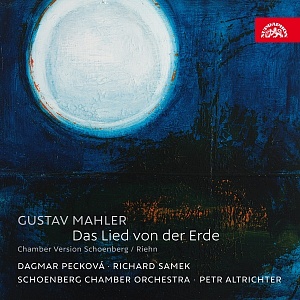
DAGMAR PECKOVÁ ON MAHLER’S DAS LIED VON DER ERDE
IT ENABLED ME TO BECOME A MEDIUM BETWEEN THE COMPOSER AND THE AUDIENCE


On March 16th 2018, Supraphon will release an album of Mahler's Das Lied von der Erde with Dagmar Pecková, Richard Samek and Schoenberg Chamber Orchestra conducted by Petr Altrichter.
Since the beginnings of her international career, mezzosoprano Dagmar Pecková has had a close connection to the work of Gustav Mahler. This is, among her other projects, documented by the highly appraised recordings with Jiří Bělohlávek and his Prague Philharmonia made under the Supraphon label in the late 1990s. To enhance the intimate character of the Song of the Earth, Pecková decided to use Schoenberg’s chamber arrangement. By creating this recording she has fulfilled her dream and also put the last gem into the mosaic of her Mahler discography.
In a short interview, Pecková ponders over her journey as a singer towards this unique work and talks about the motives that led her to initiate the new recording that she made in Prague in collaboration with tenor Richard Samek and Schoenberg Chamber Orchestra under the leadership of Petr Altrichter. You will also learn between the lines why she chose the painting The Souls of Dead Mothers by Dominik Mareš to be featured on the booklet.
Dagmar, what made you record the Song of the Earth?
I first performed the Song of the Earth, a work filled with sadness and reconciled departure from this world, when my mother was dying. I think it was only due to my emotional state at the time that I was able to grasp the thoughts hidden underneath the lyrics. For the first time in my life I experienced the feeling of having become a medium between the composer and the listeners. And this soulful work certainly helped me better understand the demise of the person so close to my heart into the “distances that are blue and bright… forever… forever”.
Subsequently I flew out into the world with the Song of the Earth – I sang it in Paris under the baton of Charles Dutoit or with the Cleveland orchestra under the leadership von Christoph von Dohnányi. For fifteen years without a break I was sharing the eternal sorrow contained in this work with audiences all over the world.
I know there are outstanding recordings such as the one sung by Christa Ludwig and conducted by Herbert von Karajan, but this did not discourage me from my intention to try and leave an imprint of my soul on the interpretation of this work, thus fulfilling and old dream of mine.
What do you appreciate in Schoenberg’s chamber arrangement?
I first became acquainted with Schoenberg’s version on the stage of London’s Wigmore Hall. I feel it gives the singer space for chamber vocal expression. I can sing even the quietest passages in a way to express what I feel without jeopardising audibility or singing under any kind of pressure. Although it has to be said that the chamber version is played by top soloists – it would be wrong to assume that the less musicians there are, the weaker the sound. This is not true at all.